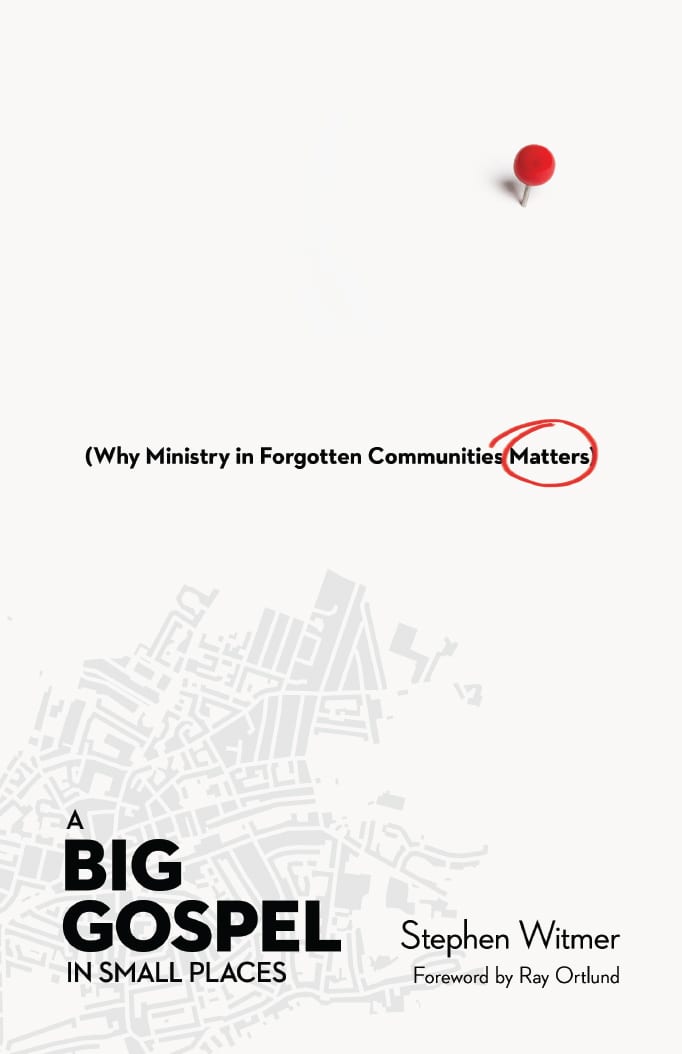It’s a popular quote, commonly attributed to Charles Spurgeon: “Discernment is not simply telling the difference between right and wrong; it’s telling the difference between right and almost right.”

A Big Gospel in Small Places: Why Ministry in Forgotten Communities Matters
Witmer, Stephen
A Big Gospel in Small Places: Why Ministry in Forgotten Communities Matters
Witmer, Stephen
This maxim, I’d suggest, also applies to ministry paradigms and practices.
In his book A Big Gospel in Small Places: Why Ministry in Forgotten Communities Matters, Stephen Witmer argues that when it comes to missions and church planting today, the prevailing paradigm that focuses on reaching urban centers of size and influence is, well, almost right—but it may be missing some important things.
Methods of Ministry
Such issues, of course, aren’t new. They’ve been with us since at least the day after Pentecost.
How shall the church decide to carry out its central calling of preaching the gospel and making disciples of all nations? The questions in Acts swirled around the mission beyond Jerusalem and Judea to Gentile people and places. To whom should the message be taken, what exactly should the message be (i.e., how much Moses?), and what should be the method? Answers that may seem fairly obvious can turn out to be only “almost right” after all. Trying to distinguish the things that differ and to discern what is best (Phil. 1:10) may well require biblical exegesis that pays closer attention to the difference between what’s descriptive and prescriptive—a distinction more easily affirmed than applied. It’s one thing to note that the apostle Paul ministered the gospel in major cities of the Roman Empire; it’s another thing to demonstrate that theological-philosophical perspectives were guiding those decisions.
Take the significant example of Paul in 1 Corinthians 1–2. The apostle has done his demographic study and cultural analysis. He knows what would be more strategic, in pragmatic terms at least, and he’s made crucial distinctions, differentiating between what would “work” for Jews (miraculous signs) and what would ring true to Gentiles (higher wisdom expressed in approved rhetoric). All of this, so far, is prudent and plausible.
The apostle Paul’s method was profoundly shaped by the message he was proclaiming. But it also worked the other way: Paul believed his method also said something crucial about his message.
But what comes next is a rather significant surprise. For just after describing the Corinthians’ pedigree (“not many of you were wise by human standards; not many were influential”), the apostle upends his previous analysis of his target audiences: “I did not come with eloquence or human wisdom as I proclaimed to you the testimony about God. For I resolved to know nothing while I was with you except Jesus Christ and him crucified.”
The point is that Paul’s method was profoundly shaped by Paul’s message. But it also worked the other way: he believed his method said something crucial about his message.
Ministry in Small Places
Here’s how Witmer—pastor of Pepperell Christian Fellowship in Pepperell, Massachusetts—expresses this perspective in relation to gospel-advancing ministry to “small places” in our own day:
Ephesians 3 shows that the purpose of the church is to manifest God’s glory. Can any one church or any one kind of church capture all of it? God used four Gospels to reveal Jesus. Might he choose to place his multifaceted glory—his power, creativity, love, patience, kindness, gentleness—on full display through many different kinds of churches in many different kinds of places? Wouldn’t we expect God to show forth various aspects of his character with particular clarity through churches wealthy and poor, big and small, in big and small places, of various cultures and ethnicities and classes? I think the answer is yes. One of the great purposes of any church, no matter what kind, is to become see-through to distinctive aspects of the character of God as revealed in the gospel. (73)
Clearly the kind of factors emphasized in the “urban priority” literature (e.g., what’s strategic and prudent) are relevant. But books like this one remind us that when it comes to the ways of God in the mission of the gospel, his “hidden wisdom” must also be deliberately considered.
We must pause to reflect, amid our planning and vision-casting, that we serve a Savior who showed up in Bethlehem, not Jerusalem; whose own perspective on carrying out his mission included leaving the 99 to find one lost sheep; and whose primary method for conquering was dying on a tree. It’s also worth remembering that—in a way no strategist’s whiteboard would have drawn it out—the gospel’s arrival in the heart of the Roman Empire happened through an arrested apostle chained to a praetorian guard. What, then, does it mean to take seriously, in our ministry perspectives and methods, that divine power “works best in weakness” (2 Cor. 12:9, NLT)?
As Witmer puts it, the application of this gospel-shaped paradigm is that
the more podunk the place, the more clearly the world will see God’s prodigality in blessing it with a servant-hearted church, a gospel-centered pastor, and leaders committed to its good. When the answer to the question, Why is your church there? couldn’t possibly be to get rich, become famous, gain influence, or maximize growth potential (all reasons the world understands), there’s a precious opportunity for the gospel’s logic to be heard: because God offered his Son for the people who live here. (82)
Small-Town Jesus
The perennial challenge in any enterprise or mission is to move from good, to better, to best when it comes to paradigms and practices. And the same is surely true for a commission as great as the one Jesus (of Nazareth!) entrusted to his disciples.
Witmer’s cultural analysis, theological reflection, sketching of related issues, and practical applications will benefit those in pastoral ministries of any size. He encourages us all to consider what it means to be gospel-centered in ways that may lay beneath the surface, and to move beyond what is “almost right” to a more profound way of seeing and doing. Witmer helpfully builds on all the important insights of the “urban priority” paradigm, but then invites us to consider what we might have missed.
For if it’s true that “the method is the message,” there may indeed be more for us to learn from the One who was sent from heavenly glory to, of all places, rural Galilee.




























